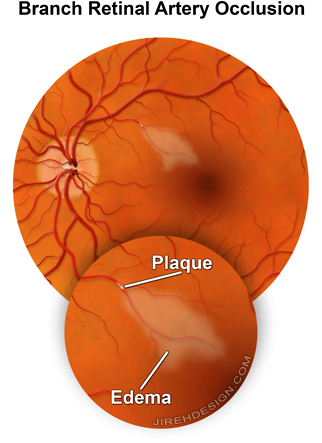Retinal Arter Okluzyonu Tanımı
Central retinal artery occlusions (CRAO) and branch retinal artery occlusions (BRAO) occur more commonly in patients with significant coronary and systemic vascular disease, that is, usually in persons at higher risk for heart attack and stroke. In these cases, an embolus (an object such as cholesterol, fat, blood clot or calcium) physically blocks the retinal artery. If the entire retinal artery is involved, it is termed a “central” retinal artery occlusion. If only a portion of the retinal vasculature is involved, it is termed a “branch” or hemi-retinal artery occlusion.
Illustration by # #
Symptoms usually include sudden, painless vision loss and can be associated with significant vision loss. Occasionally, amaurosis fugax may be noted where patients have noted temporary loss of vision “as if a shade is pulled” across the vision. This visual loss lasts normally less than 20 minutes and then returns to normal. As in many diseases, if the functional center of the retina, the macula, is involved, there may be severe loss of vision. In most cases of CRAO, there is macular involvement. In some patients, the macula is spared as an alternate blood supply exists via a “cilioretinal” artery. This cilioretinal artery may be found in about 10-15% of the population and does not become occluded during a CRAO.
In many cases, the actual embolism may be seen upon examination. Ancillary testing such as flourescein angiography may help with diagnosis, but will have no bearing on the visual outcome. Systemic evaluation should be made to determine the actual source of the embolism. Most cases of CRAO/BRAO in the older age group may be associated with significant stenosis, or narrowing, of the carotid arteries due to cholesterol. Here, a small piece of cholesterol may have broken off and become lodged in the retina. If this same embolism had traveled to the brain, a stroke may have developed. Other sources of emboli can be from the heart and can include blood clots or calcifications. Less often, blood disorders may cause artery occlusions.
Oftalmik İzlem
Ophthalmic management is really limited to looking for signs of neovascular glaucoma. This type of glaucoma may be related in situations or diseases where there is retinal ischemia (poor oxygen delivery due to poor blood supply). Neovascular glaucoma can lead to a potentially blind painful eye and can usually be prevented with timely detection.
